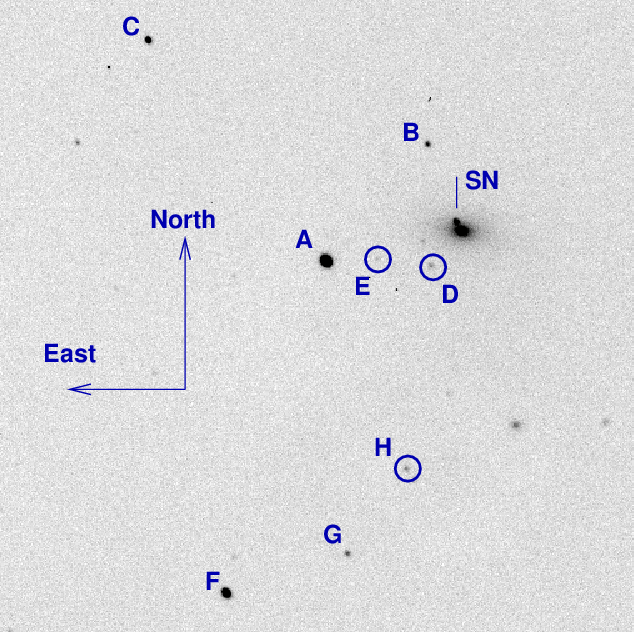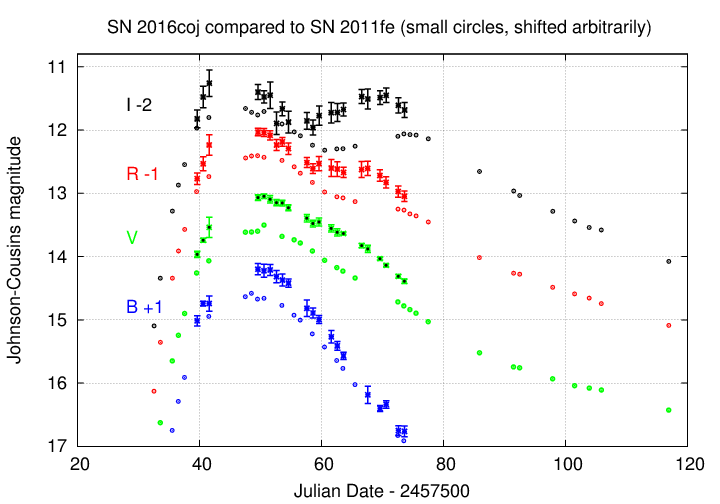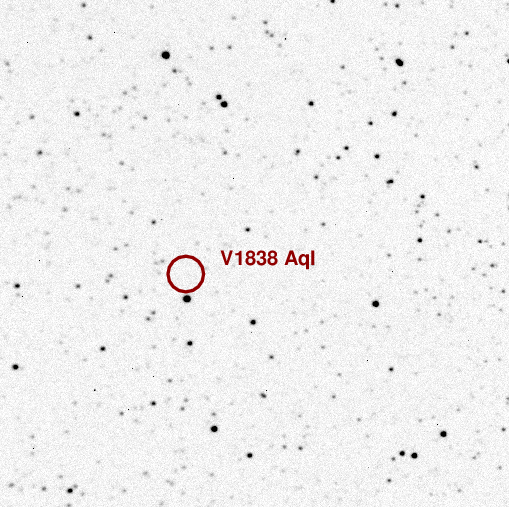
On the night of Jul 03/04, 2016, I observed SN 2016coj in NGC4125. When I heard that the cataclysmic variable star V1838 Aql might be in outburst, I took some images to confirm ... but found that it was not in outburst. Rats.
The main setup was:
Notes from the night
SN 2016coj is a Type Ia supernova in the relatively nearby galaxy NGC4125. It was discovered by the KAIT group some time before maximum light:
NGC 4125 RA = 12:08:05.7 Dec = +65:10:30 (J2000)

The AAVSO sequence team kindly provided photometry for stars near this object. You can see their full photometric sequence on their website. Below, I show only the members of that sequence which fall into my very small field of view -- taken from AAVSO sequence X16266F.
letter B sigB V sigV R sigR I sigI ------------------------------------------------------------------------ B 15.198 0.086 14.133 0.052 13.627 0.116 13.155 0.156 C 13.317 0.093 12.673 0.058 12.316 0.121 11.980 0.161 -------------------------------------------------------------------------
I've been investigating the cause for changes in the values of 30-second dark frames. Tonight's darks were taken with the chip at a constant temperature of about -12 degrees Celsius.

I was careful not to expose the CCD to any levels above 50,000 counts during the flatfielding.
Note that there is a small decrease in dark current at the end of the run, about 2 hours after other dark frames were taken. That may not be very important, but it's still annoying that there is a change.
I took sets of 15-20 images in each filter, guiding in BVRI. I used longer guide exposure times in B and I. I discarded any trailed images. I checked the focus after V and R, but it looked the same in B as it had been in the two earlier filters. I re-set it for I-band, but apparently did a poor job, as the I-band images had significantly worse FWHM than the others.
As explained in the notes to Jun 14, 2016, I used the "rotsub" technique to remove the galaxy's light at the position of the SN.
On this night, I used "method 2", which means performing "rotsub" on each individual image, then combining all the resulting images in a passband to make a "master rotsub" image.
Using aperture photometry with a radius of 4 pixels (radius of 5.5 arcsec) I measured the instrumental magnitudes of a number of reference stars and the target. Following the procedures outlined by Kent Honeycutt's article on inhomogeneous ensemble photometry, I used all stars available in each image to define a reference frame, and measured each star against this frame. I used the interim reference magnitudes above plus color terms which I am currently revising -- so please treat these results as preliminary to convert the ensemble instrumental magnitudes to the standard Johnson-Cousins BVRI scale.
Note that in the graph below, I combine data calibrated with UCAC4 photometry (first few weeks) with recent data calibrated with AAVSO photometry. That's inconsistent, and I'll re-compute all magnitudes later.
filter mag mag_uncert Julian Date
SN B = 15.763 +/- 0.086 (ens 0.053 zp 0.067) 2457573.61567
SN V = 14.389 +/- 0.035 (ens 0.027 zp 0.022) 2457573.60440
SN R = 14.046 +/- 0.082 (ens 0.023 zp 0.079) 2457573.59486
SN I = 13.684 +/- 0.118 (ens 0.031 zp 0.114) 2457573.62839
Below is a preliminary light curve, based on RIT Observatory measurements. I also show measurements of SN 2011fe in M101, an ordinary type Ia supernova, shifted arbitrarily.

During the evening, I received E-mail stating that the cataclysmic variable V1838 Aql might be in outburst, with a magnitude around V=13. After I finished acquiring images of SN 2016coj, I moved to the field of this star and, surprisingly enough, was able to find the right spot in only 10 minutes. It's right in the Milky Way, so there are stars EVERY where.
I took a few 30-second R-band images and compared them to a chart based on the Digitized Sky Survey. My picture below has North up, East left, and a field of view of about 12x12 arcminutes.

The circle shows the location of V1838 Aql, and the star just below it is roughly the expected magnitude, V=13. Clearly, I did not detect any outburst. When one other observer also reported no detection, we realized that it was a false alarm.
Oh, well. Better luck next time.
Last modified 07/04/2016 by MWR.